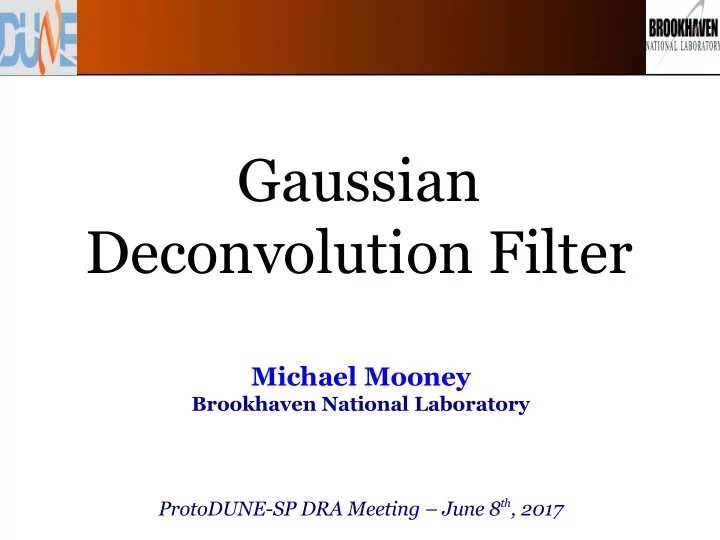

Gaussian Deconvolution Filter Michael Mooney Brookhaven National Laboratory ProtoDUNE-SP DRA Meeting – June 8 th , 2017
Introduction Introduction ♦ In ProtoDUNE-SP reconstruction, currently a “1D” deconvolution is utilized, along with a Wiener filter • 1D deconvolution: not taking into account signal induction on wires neighboring the wire closest to ionization electrons • Wiener filter: deconvolution filter that gives maximal peak-to-peak separation (“sharpness” of image) ♦ Most ideal to use 2D deconvolution (FFT over both time domain and wire domain, then remove 2D response) • BNL group (Xin et al.) has agreed to bring this technique to ProtoDUNE-SP • First releasing/tuning for MicroBooNE (~August) so this will come later for ProtoDUNE-SP (by end of the year?) ♦ Until 2D deconvolution ready, since we use GaussHitFinder, we should move to a Gaussian filter – focus of this talk 2
MicroBooNE SP Public Note MicroBooNE SP Public Note ♦ MicroBooNE has released public note documenting signal processing techniques useful for LArTPC experiments • See public note here: MICROBOONE-NOTE-1017-PUB ♦ This note describes 2D deconvolution technique • Technique improved since public note – paper forthcoming • Nature of detector response different than current assumption that only closest wire matters (see below figure) • Worst for MicroBooNE (3 mm spacing), still important for PD-SP 3
MicroBooNE SP Public Note MicroBooNE SP Public Note ♦ MicroBooNE has released public note documenting signal processing techniques useful for LArTPC experiments • See public note here: MICROBOONE-NOTE-1017-PUB ♦ This note describes 2D deconvolution technique • Technique improved since public note – paper forthcoming • Nature of detector response different than current assumption that See Backup Slides only closest wire matters (see below figure) For 2D Deconvolution Examples at MicroBooNE • Worst for MicroBooNE (3 mm spacing), still important for PD-SP 4
Signal Processing Concepts Signal Processing Concepts ♦ Also detailed in the note is the importance of a deconvolution filter – prevents noise blow-up when dividing out response Deconvolution Wiener Filter ♦ Wiener filter gives optimal peak-to-peak separation, but we are fitting to Gaussians (GaussHitFinder) → problems! 5
MicroBooNE U Plane MicroBooNE U Plane 6
MicroBooNE V Plane MicroBooNE V Plane 7
MicroBooNE Y Plane MicroBooNE Y Plane 8
Discussion Discussion ♦ If fitting post-deconvolution signal with Gaussians (GaussHitFinder), would overestimate charge with Wiener filter (peaks of integral plots) – for MicroBooNE (273 V/cm): • U Plane : overestimate charge by ~14% • V Plane : overestimate charge by ~19% • Y Plane : overestimate charge by ~18% ♦ Advantages of Gaussian filter: • Minimal bias charge extraction when using Gaussian fits • Better goodness of fit • Uniformity of dQ/dx vs. angle of track w.r.t. anode plane • No noise hits from “side bumps” associated with Wiener signal ♦ Simple to switch in code (.fcl file parameters) • First need to study/optimize for ProtoDUNE-SP 9
BACKUP SLIDES 10
2D Deconv. Example 1 2D Deconv. Example 1 11
2D Deconv. Example 2 2D Deconv. Example 2 12
Recommend
More recommend